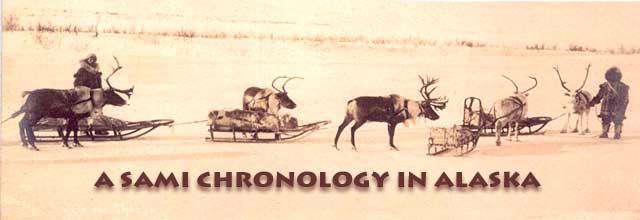
|
|

|
|
THE TIME OF ORAL TRADITION: Prior to contact with Europeans, most Indigenous languages did not contain words meaning "time" in the Western sense. Therefore no specific dates can be applied to the pre-contact ["pre-historic"] eras of the Inuit and Yup'ik or "Eskimo," Peoples of Alaska, or the Indigenous Sami, or "Lapp," People of Scandinavia. However, their oral histories indicate that they formed complex, satisfying, spiritually-based and technologically-developed cultures that did not destroy the Arctic environment. Then Europeans who based their religion and technology on the domination of nature and the subjugation of Indigenous Peoples began to move in. 15TH AND 16TH CENTURIES: An environmental crisis develops in Sápmi ["Finnmark"] when Russian and other European trappers begin the wholesale slaughter of the wild life there in order to capitalize on the growing European market for furs. The introduction of firearms among the Sami further intensifies the exploitation. The traditional Sami way of life is altered because their natural sources of food, clothing and implements are used up. In response to this crisis, reindeer nomadism - the domestication and herding of reindeer - becomes the new subsistence alternative for the Sami by the 17th century. 18TH AND 19TH CENTURIES: With the annihilation of wild game in Sápmi, the region of Alaska becomes the new target for environmental exploitation. Commercial trappers, sealers and whalers from Russia and North America bring Alaska's wild life and its Native Peoples to the same point of extinction. Russians land on the Aleutian Islands and the Alaska coast. A series of violent confrontations leads to the near-extermination of the Aleuts and lays waste to the Aleutian Islands. On the mainland the foreign invaders are met with heavy often successful Native resistance. 1823: A Russian - American treaty permitting both countries to navigate and fish the Pacific Ocean is signed without consulting the Indigenous Peoples, who see it as the first step in dividing the natural resources of Alaska between two alien powers. 1824: Russia "claims Alaska" as its territory. 1867: Alaska is "purchased" by the United States from Russia for $7,200,000. 1877: Sheldon Jackson, a Presbyterian missionary, arrives in Alaska to set up a mission at Port Clarence on the Seward Peninsula. 1880: The Alaska Commercial Company brings 14 Kamchatkan reindeer to Bering Island. 1884: On May 17th, US Congress passes the Organic Act making Alaska a civil and judicial district. A Bureau of Education is set up to oversee Native education and welfare programs. 1885: Congress appoints Sheldon Jackson as Alaska's Agent of Education. Jackson introduces boarding schools to christianize Native children. 1888: Two Samis, Samuel Balto and Ole Ravna, accompany explorer-diplomat Fridtjof Nansen and two other Norwegians on an expedition across Greenland. Balto receives a silver medal from King Oscar II of Sweden-Norway and writes a book in the Sami language about the expedition which is later translated into Norwegian as Min reise til Grønland. Balto will later come to Alaska on the Manitoba. 1890: Missionaries divide Alaska into allotments, each of which is assigned to a Protestant denomination. Due to non-Native commercial whaling and hunting practices and increased immigration, game is severely depleted in parts of Alaska and NW Canada and many Inuit and Yup'iks are starving. Jackson devises a plan to ship reindeer from Siberia as a renewable food source and to teach reindeer husbandry along with Christian dogma at the missions. He promotes the plan as an alternative to government subsidization and raises $2,156 in private donations to purchase the first reindeer and supplies. 1891: Sixteen Siberian reindeer arrive in the fall at Unalaska and Amaknak islands in Aleutians. Fourteen survive the first winter and are taken to Teller where two calves are born. These are the first of 1280 Siberian reindeer to be used as breeding stock between 1891 and 1902. Some Inuit consider this to be the introduction of a new Indigenous industry. 1892: Teller Reindeer Station is established at Port Clarence. Four Chukchi herders arrive from Siberia by boat with another 171 reindeer. Clashes occur with the Inuit about rough treatment of the animals and the Chukchi leave. |
![]()
Copyright
©
2001
BÁIKI:
the North American Sami Journal
All rights reserved


